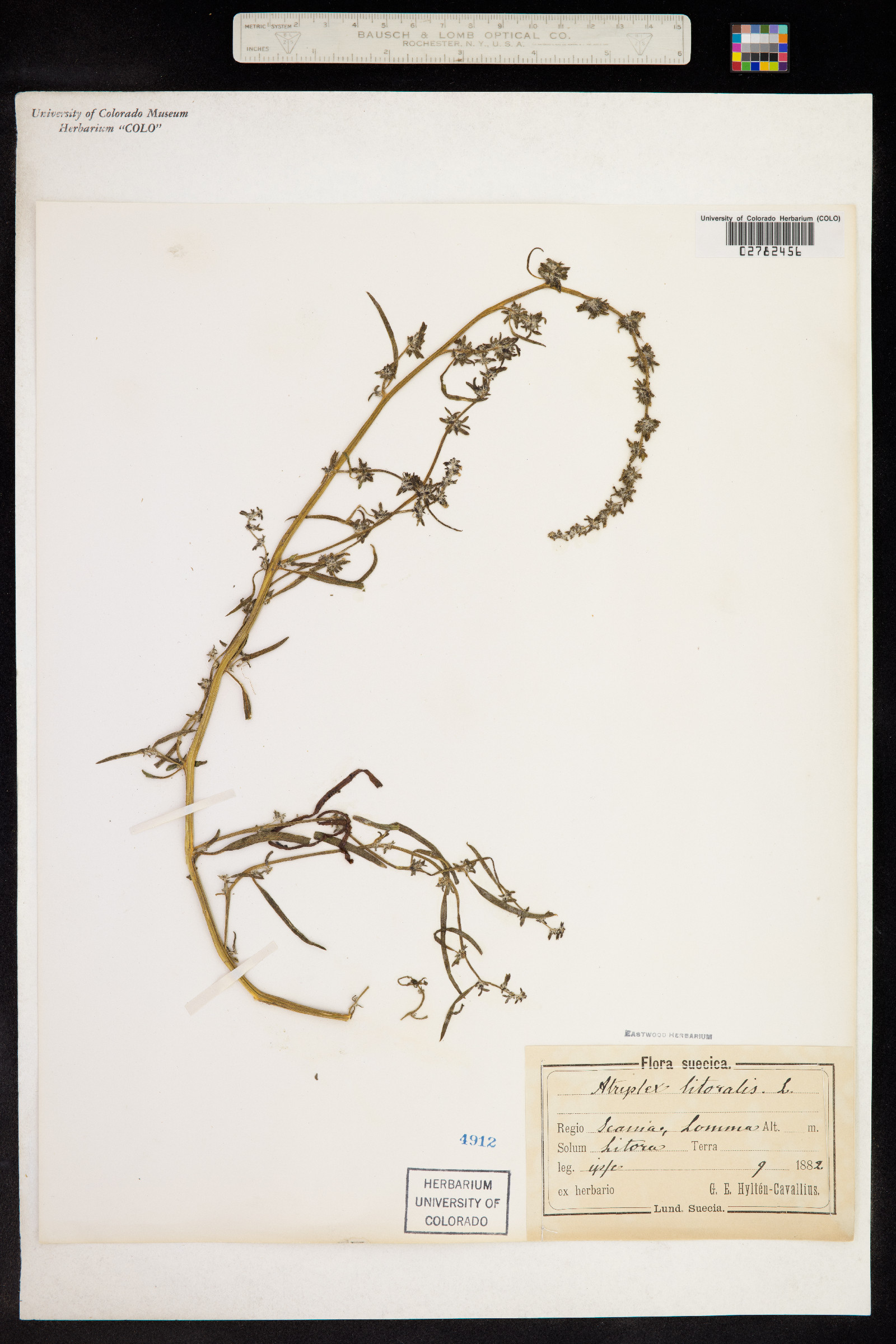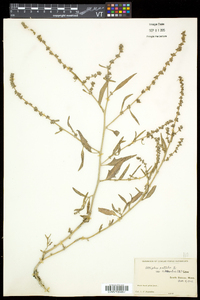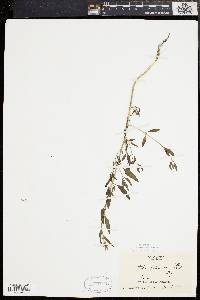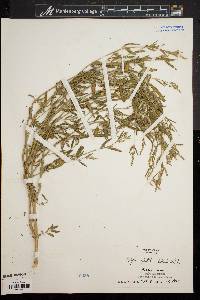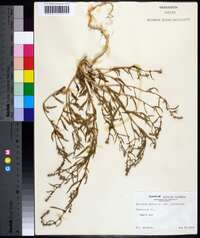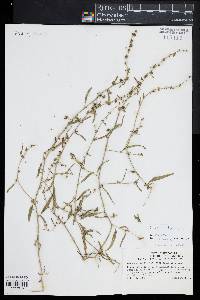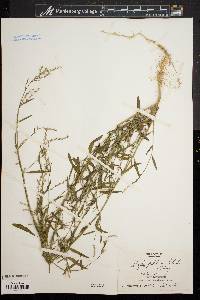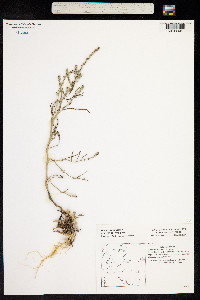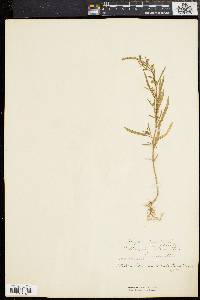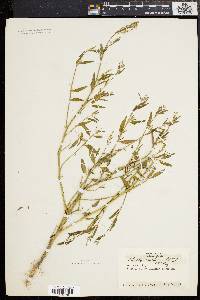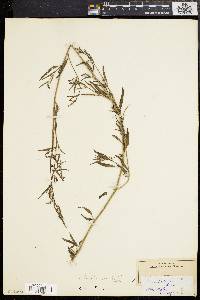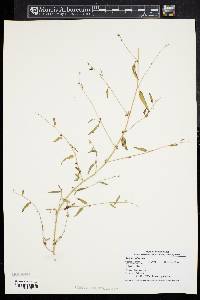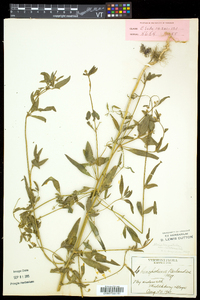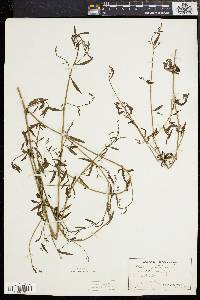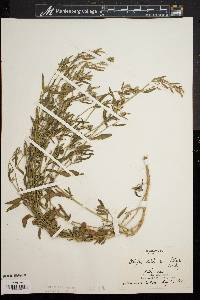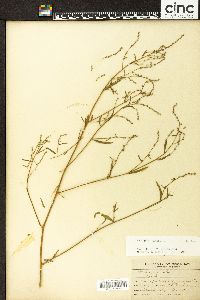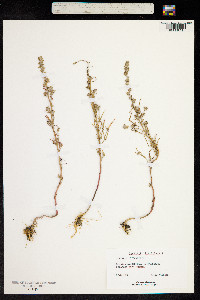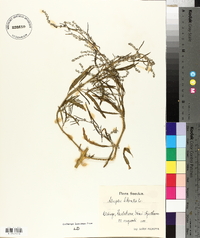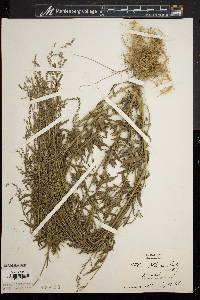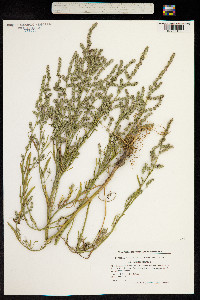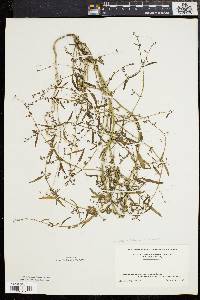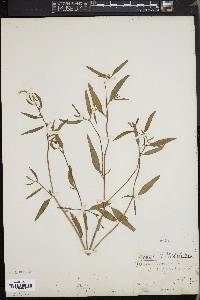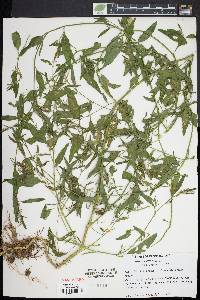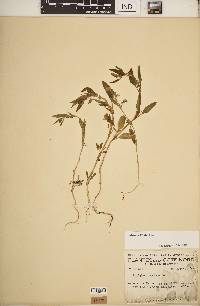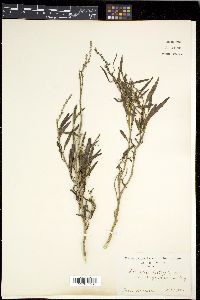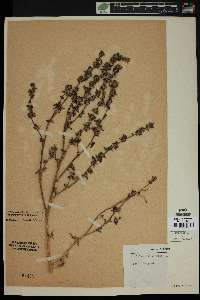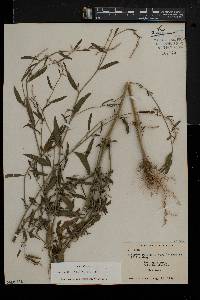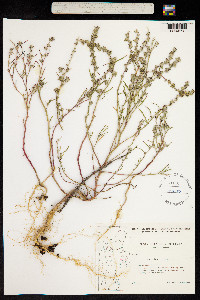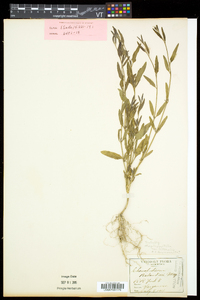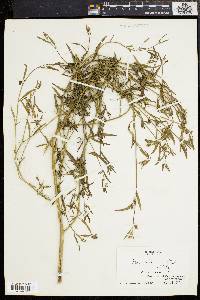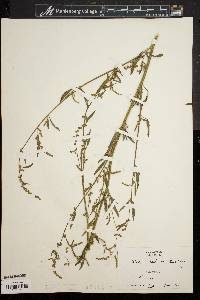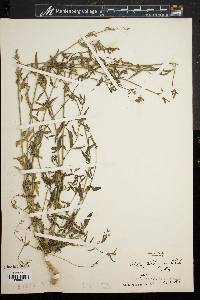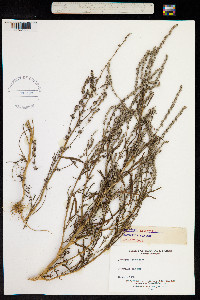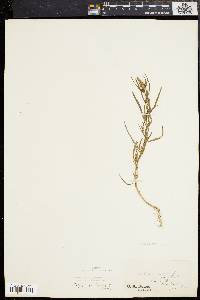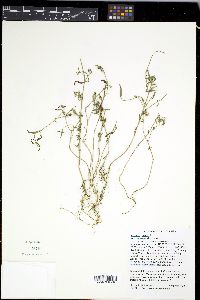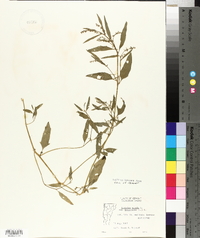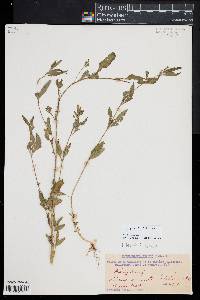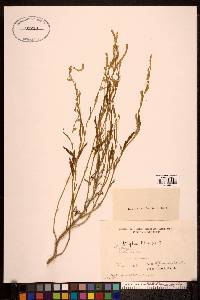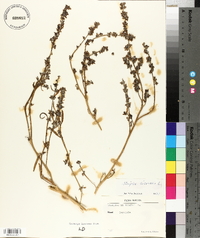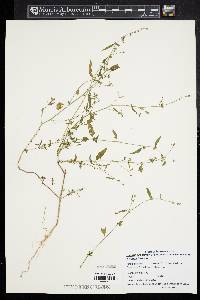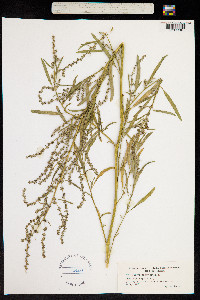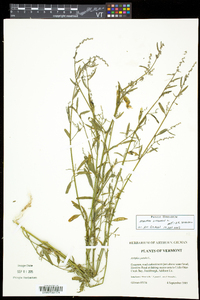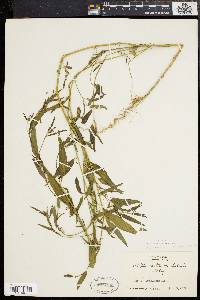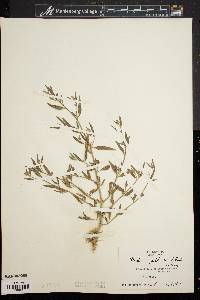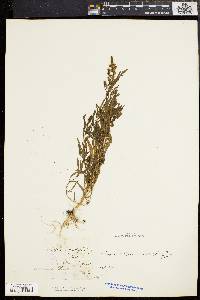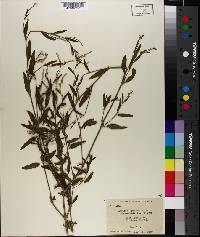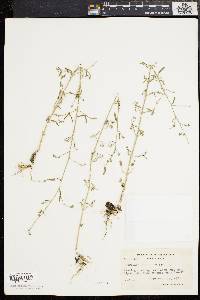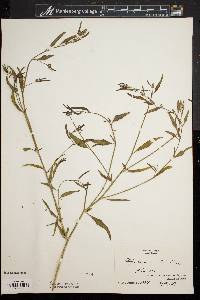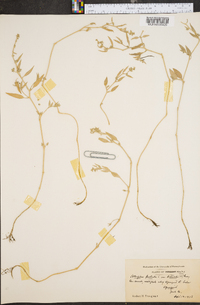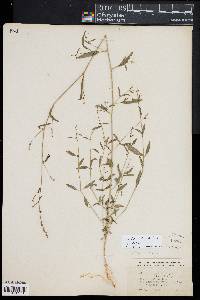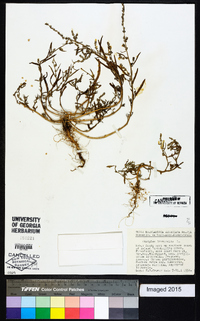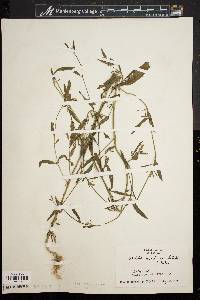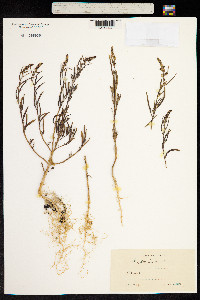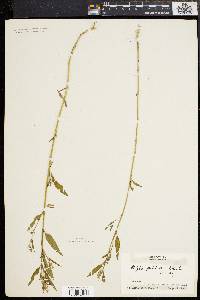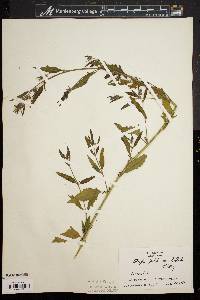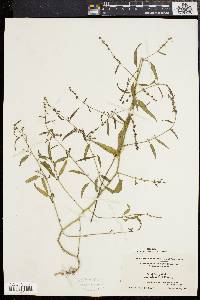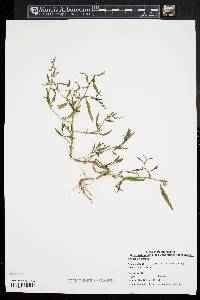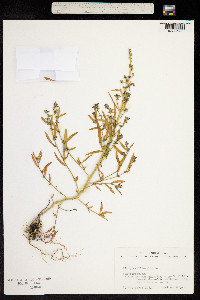
|
|
|
|
Family: Amaranthaceae
Grass-Leaf Orache
[Atriplex patula var. littoralis (L.) A. Gray] |
Herbs, monoecious or sub-dioecious, 2.5-7.5(-10) dm. Stems erect or forming sprawling tangled clumps and mostly green; branches erect-ascending, proximal ones opposite and ascending, sparsely scurfy when young, obtusely angled. Leaves alternate or only proximalmost opposite, all shortly petiolate; blade green on both surfaces, linear, linear-oblong, linear-lanceolate, or oblong, (10-)25-80(-120) × 2-8(-12) mm, thin, gradually narrowed, margin mostly entire or some sinuate-dentate with antrorse teeth, apex obtuse to acuminate. Inflorescences of long, dense or interrupted hairy spikes often forming panicle to 20 cm; staminate flowers 4-5-merous. Pistillate bracteoles sessile, triangular to ovate or ovate-rhombic, (3-)5-7 mm, mostly denticulate, rarely subentire, faces tuberculate almost distinct, green becoming brown or black. Seeds dimorphic: brown, 2-2.8 mm wide, round and ± flattened, or black, 1.5-2 mm wide, round, evenly convex; radicle inferior. 2n = 18. Flowering summer. Sea beaches and other saline habitats, old ports and ballast dumps; mainly below 100 m; introduced; N.B., N.S., P.E.I.; Ill., Ind., Maine, Mass., Mich., N.H., Ohio, Pa.; Europe. Annual or perennial herb 25 cm - 1.5 m tall Stem: upright, sometimes forming sprawling clumps, branched, branches upright to ascending, bluntly angled. Leaves: alternate (lowest ones opposite), short-stalked, 2.5 - 12 cm long, 2 - 8 mm wide, linear (lowest ones) to linear-oblong to narrowly lance-shaped or oblong with a gradually tapering base and blunt to pointed tip, thin, mostly non-toothed, more or less mealy. Inflorescence: a compact or interrupted spike of flowers, often forming a branched cluster (panicle), to 20 cm long, hairy. Flowers: either male or female, borne on the same plant (monoecious), greenish, tiny. Male flowers with four or five sepals and stamens, no petals. Female flowers without petals and sepals, enclosed within a pair of small, leaf-like bracts (bracteoles). Stigmas two. Fruit: enclosed within a pair of small bracts (bracteoles). Bracteoles united near the base, stalkless, green becoming black or brown, 3 - 7 mm long, triangular to egg-shaped or egg- diamond-shaped, mostly toothed, with small, irregular projections. Seeds brown, 2 - 3 mm wide, round, and more or less flattened, or black, 1.5 - 2 mm wide, round, and evenly convex. Similar species: Both Atriplex patula and A. prostrata are similar to A. littoralis, but their lower leaves are not linear or non-toothed along the margins. Flowering: August to September Habitat and ecology: Introduced from Eurasia. Found in a wide variety of disturbed habitats, including lawns, gardens, parkways, and waste ground. May also be found along highways because it tolerates a high degree of salinity. Occurence in the Chicago region: non-native Etymology: Atriplex is the ancient Latin name for this plant. Littoralis means "of the seashore." Author: The Morton Arboretum Erect, to 1.5 m; lvs green, the principal ones 2-12 cm, mostly linear to lanceolate or oblong and entire or merely toothed, obtuse to acuminate, narrowed to a short petiole; infls interrupted below, lfless above the base; fruiting bracteoles joined towards the ±spongy-thickened base, obscurely to evidently veined, 3-7 mm, broadly triangular to ovate, ±acute, usually with 2(-several) evident tubercles on the back; brown seeds 2-3 mm wide; black seeds 1.5-2 mm wide; radicle inferior; 2n=18. Sea beaches, and also commonly inland in saline habitats; widespread in N. Temperate regions. (A. patula ssp. l.) Most of our coastal plants are reputedly diploid, and may be intr. Inland and some coastal plants are reputedly hexaploid and probably native. (A. subspicata) Gleason, Henry A. & Cronquist, Arthur J. 1991. Manual of vascular plants of northeastern United States and adjacent Canada. lxxv + 910 pp. ©The New York Botanical Garden. All rights reserved. Used by permission. From Flora of Indiana (1940) by Charles C. Deam Prairie habitat, roadsides. Reported from: La Porte, Porter, and Steuben Counties. ...... Indiana Coefficient of Conservatism: C = null, non-native Wetland Indicator Status: FACU Diagnostic Traits: lowest leaves opposite, linear to lanceolate oblong, with scurfy scales; flowers all unisexual and female ones borne between conspicuous, deltate bracteoles.
|

